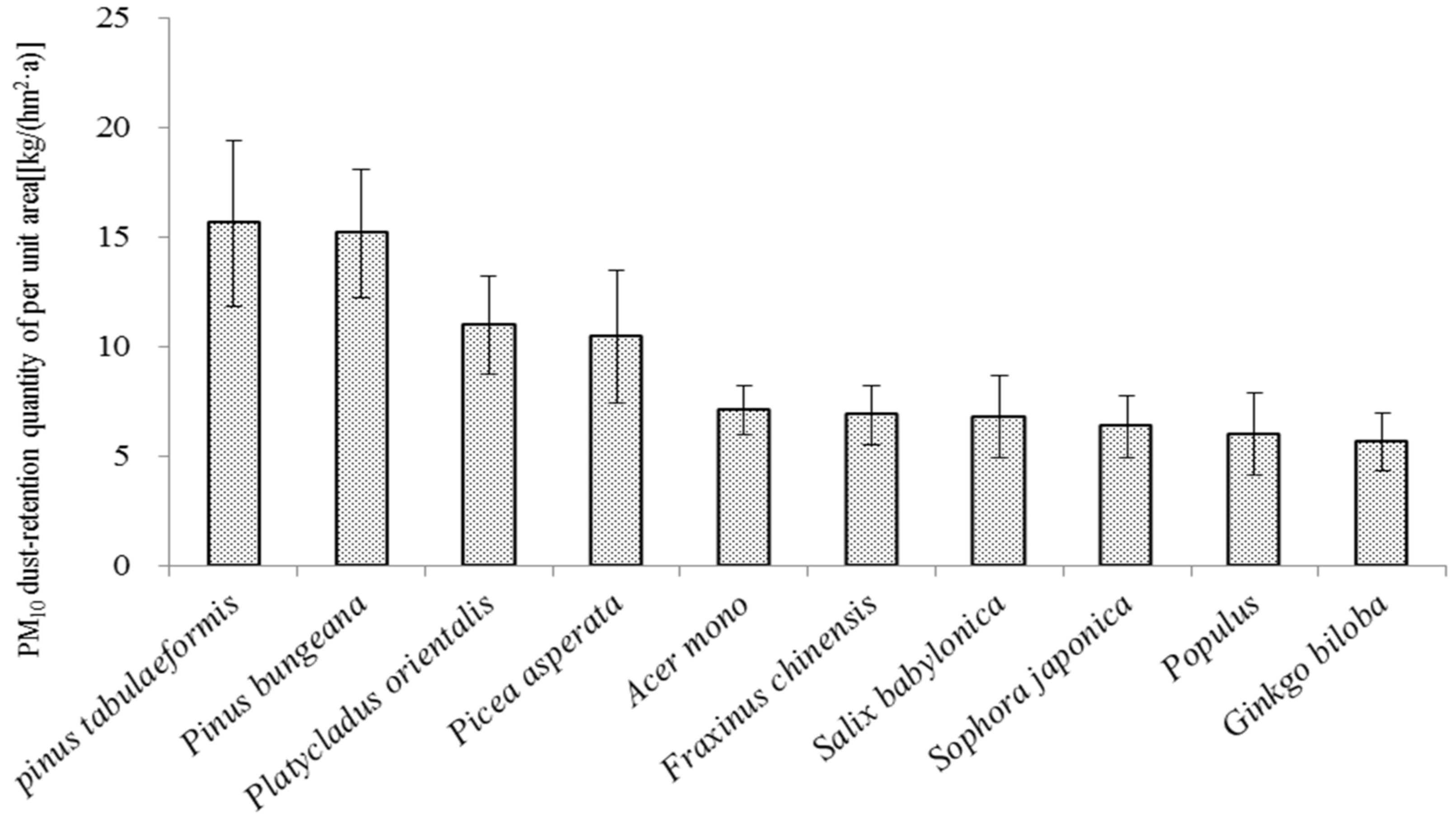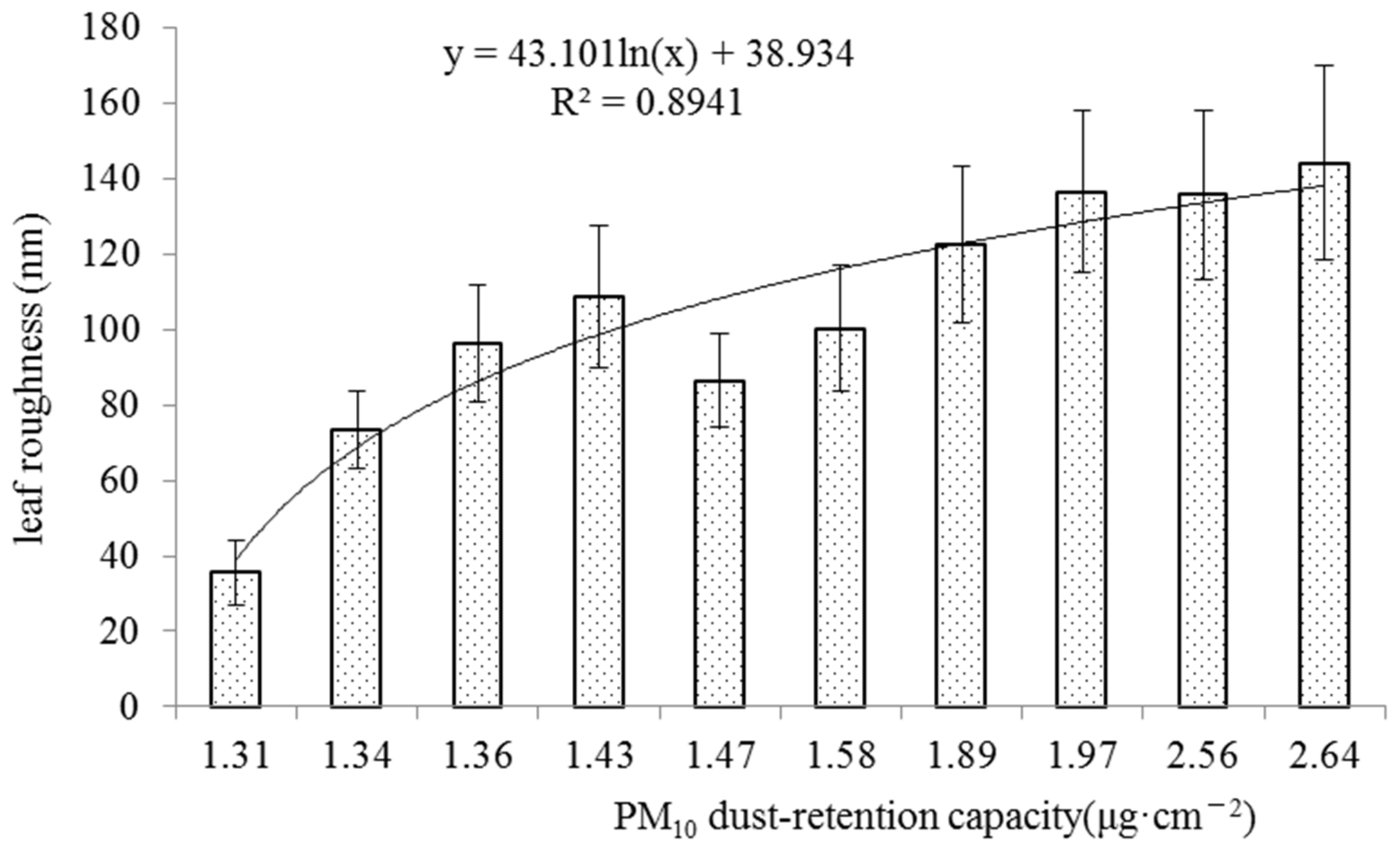PM10 and PM2.5 Dust-Retention Capacity and Leaf Morphological Characteristics of Landscape Tree Species in the Northwest of Hebei Province
Abstract
:1. Introduction
2. Materials and Methods
2.1. Selection of Tree Species
2.2. Foliage Collection Method
2.3. Determination of PM2.5 and PM10 Absorption Capacity of Tree Species
2.4. Roughness of Leaf Surface of Different Tree Species
2.5. Leaf Surface Micromorphological Structure of Different Tree Species
3. Results and Analysis
3.1. Analysis of PM10 Dust-Retention Capacity of Different Tree Species
3.2. Analysis of PM2.5 Dust-Retention Capacity of Leaves of Different Tree Species
3.3. Relationship between Particulate Matter Dust-Retention Capacity and Leaf Morphological Characteristics of Different Tree Species
3.3.1. Relationship between Morphological and Leaf Surface Characteristics of Different Tree Species and Particulate Matter Dust-Retention Capacity
3.3.2. Relationship between Particulate Matter Dust-Retention Capacity and Leaf Roughness of Different Tree Species
4. Discussion
4.1. Analysis of the Differences in PM10 and PM2.5 Dust-Retention Capacities of Different Tree Species
4.2. Relationship between Particulate Matter Dust-Retention Capacity and Leaf Morphological Characteristics of Different Tree Species
5. Conclusions
Author Contributions
Funding
Institutional Review Board Statement
Informed Consent Statement
Conflicts of Interest
References
- Zhang, R.J.; Wang, M.F.X.; Hu, F.; Xu, Y.F. Elemental concentrations and distributions of atmospheric particles before and in heating period in Beijing. J. Univ. Chin. Acad. Sci. 2002, 19, 75–81. [Google Scholar]
- Shen, L.F.; Guo, Z.G.; Gao, H.W.; Zhang, Y.J.; Chen, H.T. Preliminary study on element composition and source apportionment of atmospheric aerosol over Bohai Sea. Environ. Monit. China 2005, 21, 16–21. [Google Scholar]
- Shi, Y.; Matsunaga, T.; Yamaguchi, Y.; Zhao, A.M.; Li, Z.Q.; Gu, X.F. Long-term trends and spatial patterns of satellite-retrieved PM2.5 concentrations in south and southeast Asia from 1999 to 2014. Sci. Total Environ. 2018, 615, 177–186. [Google Scholar] [CrossRef] [PubMed]
- Voliotis, A.; Samara, C. Submicron particle number doses in the human respiratory tract: Implications for urban traffic and background environments. Environ. Sci. Pollut. Res. 2018, 25, 33724–33735. [Google Scholar] [CrossRef]
- Samek, L.; Stegowski, Z.; Styszko, K.; Furman, L.; Fiedor, J. Seasonal contribution of assessed sources to submicron and fine particulate matter in a Central European urban area. Environ. Pollut. 2018, 241, 406–411. [Google Scholar] [CrossRef]
- Liu, Y.H.; Hou, Y.J.; Shu, D.Y.; Yang, B.; Cui, Y.C.; Ding, F.J. Properties and spatio-temporal variation of leaf retained particulate matters of the main tree species planted in Guiyang City. Sci. Silvae Sin. 2020, 56, 12–25. [Google Scholar]
- Wang, Z.S.; Li, Y.T.; Liu, B.X.; Sun, F.; Zhang, D.W.; Zhou, J.N.; Liu, Z.Y.; Pan, L.B. Chemical characteristics of PM2.5 in Beijing. Acta Ecol. Sin. 2016, 36, 2382–2392. [Google Scholar]
- Zhangjiakou Municipal Bureau of Statistics. Statistical Bulletin of National Economic and Social Development of Zhangjiakou in 2019; Zhangjiakou Municipal Bureau of Statistics: Zhangjiakou, China, 2020. [Google Scholar]
- Department of Ecological Environment of Hebei Province. Bulletin of Ecological Environment of Hebei Province in 2019; Department of Ecological Environment of Hebei Province: Shijiazhuang, China, 2020. [Google Scholar]
- Chen, B.; Xu, J.J.; Liu, D.H.; Yang, X.B. Response of Ginkgo biloba growth and physiological traits to ozone stress. Glob. Ecol. Conserv. 2022, 34, e02020. [Google Scholar] [CrossRef]
- Lu, S.W.; Yang, X.B.; Li, S.N.; Chen, B.; Jiang, Y.; Wang, D.; Xu, L. Effects of plant leaf surface and different pollution levels on PM2.5 adsorption capacity. Urban For. Urban Green. 2018, 34, 64–70. [Google Scholar] [CrossRef]
- Lu, S.W.; Li, S.N.; Chen, B.; Liu, H.L.; Zhao, D.B.; Chen, P.F. Variations in PM2.5 concentration and leaf adsorption capacity of Pinns tabulaeformis forests at different altitudes on Beijing Xishan Mountains. Acta Ecol. Sin. 2017, 37, 6588–6596. [Google Scholar]
- Li, J.D. Characteristics of PM2.5 Pollution and Source Change in Zhangjiakou under the Background of Clean Atmospheric Environment in the Mountainous Areas on the Northwest Margin of Beijing Tianjin Hebei. Master’s Thesis, Nanjing University of Information Science and Technology, Nanjing, China, 2021. [Google Scholar]
- Zhang, W.K.; Wang, B.; Niu, X. Dynamic research on particulates-absorbing capacities of common tree species leaves in Beijing over time. Acta Sci. Circumstantiae 2016, 36, 3840–3847. [Google Scholar]
- Niu, X.; Wang, B.; Wei, W.J. Response of the particulate matter capture ability to leaf age and pollution intensity. Environ. Sci. Pollut. Res. 2020, 27, 34258–34269. [Google Scholar] [CrossRef]
- Beckett, K.P.; Freer-Smith, P.H.; Taylor, G. Particulate pollution capture by urban trees: Effect of species and windspeed. Glob. Chang. Biol. 2000, 6, 995–1003. [Google Scholar] [CrossRef]
- Zhang, L.; Zhang, Z.; Chen, L.; McNulty, S. An investigation on the leaf accumulation-removal efficiency of atmospheric particulate matter for five urban plant species under different rainfall regimes. Atmos. Environ. 2019, 208, 123–132. [Google Scholar] [CrossRef]
- Chen, B.; Li, S.N.; Lu, S.W.; Liu, H.L.; Zhao, D.B.; Chen, P.F. Function study of coniferous species leaf retention of PM2.5 in winter in Xishan mountain of Beijing. Environ. Sci. Technol. 2018, 41, 28–33. [Google Scholar]
- Zhao, C.X.; Wang, Y.J.; Wang, Y.Q.; Zhang, H.L. Interactions between fine particulate matter (PM2.5) and vegetation: A review. Chin. J. Ecol. 2013, 32, 2203–2210. [Google Scholar]
- Li, H.M.; Liu, X. Relationships between leaf epidermal morphology and dust-retaining capability of main garden trees in Chengyang district of Qingdao. Chin. J. Ecol. 2008, 27, 1659–1662. [Google Scholar]
- Wang, L.; Ha, S.; Liu, L.Y.; Gao, S.Y. Effects of weather condition in spring on particulates density on conifers leaves in Beijing. Chin. J. Ecol. 2006, 25, 998–1002. [Google Scholar]
- Luo, J.; Niu, Y.D.; Zhang, Y.; Zhang, M.; Tian, Y.X.; Zhou, X.L. Dynamic analysis of retention PM2.5 by plant leaves in rainfall weather conditions of six tree species. Energy Sources Part A Recovery Util. Environ. Eff. 2020, 42, 1014–1025. [Google Scholar] [CrossRef]
- Wang, H.X.; Shi, H.; Wang, Y.H. Dynamics of the captured quantity of particulate matter by plant leaves under typical weather conditions. Acta Ecol. Sin. 2015, 35, 1–12. [Google Scholar] [CrossRef]
- Nowak, D.J.; Hirabayashi, S.; Bodine, A.; Hoehn, R. Modeled PM2.5 removal by trees in ten U.S. cities and associated health effects. Environ. Pollut. 2013, 178, 395–402. [Google Scholar] [CrossRef] [PubMed]
- Chen, B.; Jiang, Y.; Lu, S.W.; Li, S.N.; Chen, P.F.; Liu, H.L.; Zhao, D.B. Relationship between PM2.5 adsorption and wettability of different trees during summer, autumn in West Mountain of Beijing. J. Nanjing For. Univ. (Nat. Sci. Ed.) 2018, 42, 113–119. [Google Scholar]






| Tree Species | Height (m, Mean ± SD) | Breast Diameter (cm, Mean ± SD) | Crown Width (m) | |
|---|---|---|---|---|
| East–West (Mean ± SD) | North–South (Mean ± SD) | |||
| Pinus tabulaeformis | 7.85 ± 2.45 | 12.04 ± 3.54 | 2.33 ± 0.45 | 2.58 ± 0.58 |
| Platycladus orientalis | 7.04 ± 3.22 | 11.54 ± 2.87 | 2.45 ± 0.47 | 2.54 ± 0.65 |
| Pinus bungeana | 5.88 ± 2.12 | 10.24 ± 2.14 | 2.68 ± 0.58 | 2.55 ± 0.45 |
| Picea asperata | 6.58 ± 1.58 | 11.55 ± 2.54 | 1.25 ± 0.33 | 1.35 ± 0.54 |
| Ginkgo biloba | 9.88 ± 3.64 | 14.25 ± 3.54 | 1.68 ± 0.24 | 1.85 ± 0.74 |
| Salix babylonica | 10.85 ± 5.64 | 16.54 ± 4.14 | 3.54 ± 1.02 | 4.55 ± 1.58 |
| Populus | 14.53 ± 6.54 | 22.54 ± 4.75 | 4.12 ± 1.88 | 3.85 ± 1.68 |
| Fraxinus chinensis | 12.53 ± 3.45 | 19.54 ± 3.25 | 3.12 ± 1.42 | 2.57 ± 1.44 |
| Sophora japonica | 11.33 ± 3.58 | 15.32 ± 3.54 | 2.85 ± 2.01 | 3.02 ± 1.85 |
| Acer mono | 7.85 ± 3.55 | 12.78 ± 2.47 | 2.24 ± 1.02 | 2.64 ± 1.33 |
| Tree Species | April | May | June | July | August | September | October | Mean ± SD |
|---|---|---|---|---|---|---|---|---|
| Pinus tabulaeformis | 1.81 | 1.70 | 1.99 | 1.50 | 1.38 | 3.96 | 5.03 | 2.64 ± 1.29 |
| Platycladus orientalis | 1.86 | 1.62 | 1.59 | 1.32 | 0.94 | 2.69 | 3.77 | 1.97 ± 0.89 |
| Pinus bungeana | 1.82 | 2.01 | 2.34 | 1.91 | 1.71 | 3.12 | 4.98 | 2.56 ± 1.08 |
| Picea asperata | 1.21 | 2.15 | 1.18 | 1.60 | 0.28 | 2.99 | 3.79 | 1.89 ± 1.10 |
| Ginkgo biloba | 0.79 | 1.33 | 1.05 | 1.27 | 0.25 | 2.20 | 2.28 | 1.31 ± 0.68 |
| Salix babylonica | 1.16 | 1.67 | 1.11 | 1.02 | 0.37 | 2.11 | 2.54 | 1.43 ± 0.68 |
| Populus | 0.76 | 1.10 | 1.02 | 0.95 | 0.17 | 2.93 | 2.43 | 1.34 ± 0.90 |
| Fraxinus chinensis | 0.72 | 1.04 | 1.15 | 1.69 | 0.90 | 2.49 | 2.29 | 1.47 ± 0.65 |
| Sophora japonica | 0.82 | 1.05 | 1.15 | 1.01 | 0.70 | 2.48 | 2.31 | 1.36 ± 0.67 |
| Acer mono | 1.07 | 1.38 | 1.28 | 1.92 | 0.86 | 2.48 | 2.08 | 1.58 ± 0.55 |
| Mean | 1.20 ± 0.46 | 1.53 ± 0.40 | 1.41 ± 0.48 | 1.44 ± 0.33 | 0.79 ± 0.56 | 2.75 ± 0.53 | 3.17 ± 1.12 | 1.75 ± 0.80 |
| Tree Species | April | May | June | July | August | September | October | Mean ± SD |
|---|---|---|---|---|---|---|---|---|
| Pinus tabulaeformis | 0.54 | 0.68 | 0.85 | 0.75 | 0.45 | 0.73 | 1.60 | 0.80 ± 0.35 |
| Platycladus orientalis | 0.42 | 0.78 | 0.81 | 0.56 | 0.36 | 0.73 | 1.24 | 0.70 ± 0.27 |
| Pinus bungeana | 0.31 | 0.67 | 0.85 | 0.74 | 0.44 | 0.71 | 1.44 | 0.74 ± 0.33 |
| Picea asperata | 0.41 | 0.46 | 0.45 | 0.60 | 0.37 | 0.81 | 1.32 | 0.63 ± 0.31 |
| Ginkgo biloba | 0.09 | 0.16 | 0.34 | 0.33 | 0.24 | 0.64 | 0.68 | 0.35 ± 0.21 |
| Salix babylonica | 0.32 | 0.38 | 0.39 | 0.24 | 0.23 | 0.66 | 0.84 | 0.54 ± 0.21 |
| Populus | 0.24 | 0.14 | 0.32 | 0.31 | 0.23 | 0.59 | 0.77 | 0.37 ± 0.21 |
| Fraxinus chinensis | 0.20 | 0.11 | 0.43 | 0.54 | 0.34 | 0.64 | 0.71 | 0.42 ± 0.20 |
| Sophora japonica | 0.20 | 0.17 | 0.43 | 0.48 | 0.31 | 0.42 | 0.72 | 0.39 ± 0.17 |
| Acer mono | 0.12 | 0.32 | 0.54 | 0.53 | 0.34 | 0.54 | 0.63 | 0.43 ± 0.16 |
| Mean | 0.28 ± 0.13 | 0.39 ± 0.24 | 0.54 ± 0.20 | 0.51 ± 0.16 | 0.33 ± 0.08 | 0.65 ± 0.11 | 0.99 ± 0.36 | 0.53 ± 0.16 |
Publisher’s Note: MDPI stays neutral with regard to jurisdictional claims in published maps and institutional affiliations. |
© 2022 by the authors. Licensee MDPI, Basel, Switzerland. This article is an open access article distributed under the terms and conditions of the Creative Commons Attribution (CC BY) license (https://creativecommons.org/licenses/by/4.0/).
Share and Cite
Gao, Z.; Qin, Y.; Yang, X.; Chen, B. PM10 and PM2.5 Dust-Retention Capacity and Leaf Morphological Characteristics of Landscape Tree Species in the Northwest of Hebei Province. Atmosphere 2022, 13, 1657. https://doi.org/10.3390/atmos13101657
Gao Z, Qin Y, Yang X, Chen B. PM10 and PM2.5 Dust-Retention Capacity and Leaf Morphological Characteristics of Landscape Tree Species in the Northwest of Hebei Province. Atmosphere. 2022; 13(10):1657. https://doi.org/10.3390/atmos13101657
Chicago/Turabian StyleGao, Zewei, Yahang Qin, Xinbing Yang, and Bo Chen. 2022. "PM10 and PM2.5 Dust-Retention Capacity and Leaf Morphological Characteristics of Landscape Tree Species in the Northwest of Hebei Province" Atmosphere 13, no. 10: 1657. https://doi.org/10.3390/atmos13101657





